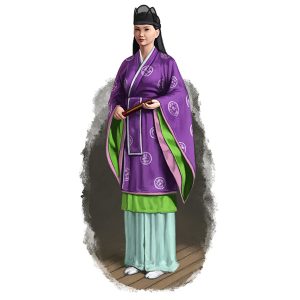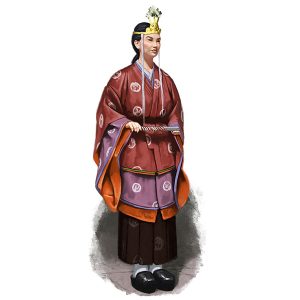As I mentioned in my post about male priestly vestments, the vestments for female priests are different. When female priests were officially permitted after the war, the vestments were initially based on the formal clothes for female Heian aristocrats, just as those for men were based on those for male aristocrats. However, the robes of female courtiers, the “jūnihitoë”, or “twelve robes”, have multiple layers, are very heavy, and are difficult to move in. As a result, it was not long before a revised version was specified, based, as I recall, on the vestments of the female ritual attendants in the Imperial palace.
Just as for men, the base is a white kimono and hakama that are normally coloured, with the ranks of female priests being indicated by the same colours as those of male priests. (There is no distinction between male and female priests in the regulations for ranks.) The vestments worn over the top are, however, quite different.

Click image for larger version.
She is wearing a hitai-atë on her head, and holding a bonbori fan in her hands. The fan has fifteen struts, but is never opened during matsuri. Just as for the shaku carried by men, there are detailed rules for how a priest should hold the fan, and what to do with it while bowing and clapping.

Click image for larger version.
The first layer over the kimono and hakama is the hitoë, which must be worn with this level of vestments, and which must be this colour, or a yellow-green. She is also wearing an awagi over the hitoë, the purple layer. Over the top of that, she is wearing a karaginu. (Note: not a “kariginu”, which is part of the male vestments, but a “karaginu”.) The colour of the awagi and karaginu are largely up to the priest, as long as she avoids the forbidden colours.
Her fan is a cypress fan with sixteen struts, decorated and with coloured cords passed through the top of each strut. Those cords are wrapped around the fan, and it is never opened during a matsuri. As the fans are never opened, I confess that I do not know whether they are made so that they can be opened, or whether it has become purely symbolic.
Her headgear is a called a “saishi”. It is made of gilded metal, with artificial flowers, and white threads hanging down at the sides. The flowers are required as part of the vestments, and orange and/or white seem to be most common, but I do not think they are specified precisely in the regulations. (I have the regulations, and they do not seem to specify colour or type, but the phrase used to refer to them, “kokoroba”, may be more specific than it looks, or than a net search suggests.)
Female priests normally wear their hair long, and gathered into a single ponytail. (The priest on the left is being a bit of a rebel by wearing it loose; the regulations do not require the ponytail, but they do strongly suggest it.) Priests who prefer to keep their hair short often wear false ponytails for matsuri.
The regulations still, I believe, allow female priests to wear the old-style vestments. This was permitted as a temporary measure so that priests would not have to pay for a full new set of vestments all of a sudden, and I do not believe it has been cancelled yet. However, I have never seen a female priest at a jinja perform a matsuri in the old-style vestments; they would be really inconvenient.
This covers the priests, but still leaves miko. I will do a post about them soon.
Dear David,
I was introduced to your site today by watching the YouTube video, “Japan: Where Gods Aren’t Gods and Worshipers Aren’t Religious (Shinto Explained).” An excellent introduction to Shinto. I have been visiting Shinto shrines during my visits to Japan since I lived in Tokyo for two years in the early 1990s. Most have been pleasant peaceful places. One was extremely unpleasant. Now that I’m retired and living in Japan (near Fukuoka), I have again begun visiting the shrines and enjoying solitude and a peaceful natural environment. If you don’t mind, I do have two questions for you:
1. Is it just me or has attendance at Shinto shrines declined in recent years; or is it because I’m residing in a more rural area now?
2. I have noticed several shrines that appear to have been abandoned. How does one “take over” one of those shrines in terms of maintenance and operation?
Regards,
Robert
Robert,
I’m glad you liked the video. On to your questions.
1. It is because you are residing in a more rural area now. Overall, I think attendance at jinja has actually been going up in recent years, but the general flow of population to Tokyo means that rural jinja face serious problems. This is something that Jinja Honchō is well aware of, and trying to do something about.
2. That’s a tricky question. You can do a bit of tidying up whenever you pay your respects, but to do more than that, you would need to find out whether the jinja was a religious corporation or not. If not, it is someone’s private property, and so you need to find out who that is, and talk to them. If it is, you need to find out who the chief priest is, and talk to them. You might well need to talk to the sodai and ujiko after that. A good place to start would be Fukuoka Jinjachō, which will be able to tell you if they are religious corporations or not, and put you in touch with the chief priest if they are. My impression is that rural jinja are basically glad of any offer of help, but that negotiations over the details of that help may not go as smoothly as you might expect, because there are local traditions that people take very seriously. On the other hand, you might find that they are eager for any help you can offer, and that everything goes smoothly. The key, I think, is to offer help, but let them suggest the form it should take. (This is based on my experiences with my local jinja, and articles in Jinja Shinpō about actions in rural areas.) Fukuoka is one of the few Jinjachō without a homepage, but their phone number is 092(641)3505.
I hope that helps.
David
I find it fascinating that there are such difference in Shinto vestments for the different genders. I would have thought that it would have been male priests who would have been given fewer guidelines, not the females. I find it fascinating that there are such variations. How many different ranks are there within the Shinto priesthood? You mentioned it before, so I am quite curious.
The vestments for male priests follow the rules defined by law in the pre-War period, which is why they are very strict. Women’s vestments were defined with a bit more leeway, later.
If I’ve counted up correctly, there are fifteen (maybe sixteen, depending on whether you think one of them counts as a rank) different ranks, in three parallel sets, which are quite closely correlated, but not strictly linked. The Shinto People essay from my Patreon explains it all, but it’s too complex to cover in a comment on my blog.